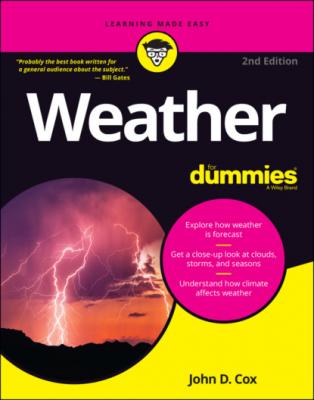Weather For Dummies. John D. Cox
Читать онлайн.| Название | Weather For Dummies |
|---|---|
| Автор произведения | John D. Cox |
| Жанр | |
| Серия | |
| Издательство | |
| Год выпуска | 0 |
| isbn | 9781119811022 |
But behind every storm and every heatwave and every cold snap is a cast of characters that are responsible for the whole production. They make the winds blow. They form the clouds. Chapter 5 answers the question, “why all this wind?” and explains how air pressure is the cause. In Chapter 6, you pick up a little Latin: cirrus, stratus, cumulus, nimbus. Can you tell one type of cloud from another? This chapter also gives you the lowdown on all forms of clouds and how you can tell if there’s rain on the way or something a bit more sinister brewing. And there are two pages of color photographs in this book devoted to the basic cloud types that are spelled out in this part.
It’s Seasonal
If you live in the same part of the world very long, eventually you get fairly set in your ways about what to expect of the different seasons through the year. Winter, spring, summer, and fall have certain personalities, certain kinds of storms, certain ranges of temperature. And fair weather has a different feel to it from one season to the next.
Part 3 is organized around this general idea about different seasons coming in different varieties of weather. It begins with the big storms of winter, focuses on the tornadoes of spring and the thunderstorms and temperature extremes of summer, and it takes a good look at hurricanes that reach their seasonal peak in autumn. It is helpful as far as it goes, this way of organizing our thoughts, but it’s worth remembering that every region of the globe has its own variety of seasons.
But it’s not just latitude, you know, your distance from the Equator, that shapes the seasons. Early New England settlers learned that the hard way, having left England expecting to land in a climate akin to the south of France. As it happens, Sacramento, California, has the same latitude as Washington, D.C., on the other side of the continent, yet all their seasons are very different from one another. Chapter 10 tells you why.
Something else is going on with the seasons. Changes in the composition of our atmosphere are changing these annual climate patterns. Winters are getting shorter, summers are getting longer, and the arrival times of all seasons are less reliable than they used to be. So look at Part 3 as a set of flexible guidelines that are subject to change, as a way of organizing some thinking about the weather events in your life.
A Changing Climate
If you want to know the signs of a changing climate, look through Chapter 13 and see what it is doing to our weather. This is where climate hits the road, and where climate science has traveled far since the days when the first edition of Weather For Dummies hit the press. Generalized expectations have evolved into specific cases in point.
Heads Up!
There’s a lot going on in the sky. Unfortunately for people who live in many major cities, the sky over their heads is clogged with extra gases and other material that has been dumped into it. Weather doesn’t put that stuff up there, of course, but it sure has a lot to do with how bad it gets. Chapter 14 takes a deep dive into air pollution and looks at all that stuff in the sky that didn’t used to be there and doesn’t belong there.
When the sky is clear of pollution, however, there are some marvelous things going on. Effects like rainbows and sun dogs and haloes that form around the Sun and the moon have been drawing rave reviews as long as people have been looking up. Part 5 describes how the atmosphere bends the light and plays all sorts of tricks on our eyes.
Are you thinking about getting up close and personal with the weather? This part also describes cool weather experiments and famous weather experimenters and takes a look at what you need to set up your own weather station.
There is weather, and then there is weather. Once in a while, a storm or climate event like a drought comes along that is so terrible that it is remembered from one generation to another. It makes history. Part 6 takes a look at the most destructive storms in recent memory in the United States and around the world that made the weather hall of fame.
Before there was weather science there were other ways of trying to figure out what the atmosphere was up to. This part also gives you a good look at weather lore, some of the famous sayings and proverbs and signs that have been passed down through the ages.
Where do you go from here? Weather data and other information about the weather is a huge part of the Internet, and in the Appendix, you can find a list of major weather websites to get you started in the right direction.
Chapter 2
Forecasts and Forecasting
IN THIS CHAPTER
Accurately and precisely forecasting weather is a very hard thing to do. In fact, a 100 percent accurate forecast is impossible.
